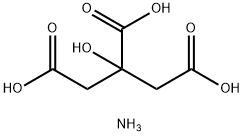2-Hydroxy-1,2,3-propanetricarboxylic acid/ammonia,(1:x)
- CAS NO.:7632-50-0
- Empirical Formula: C6H11NO7
- Molecular Weight: 209.15
- MDL number: MFCD00013068
- EINECS: 231-560-6
- SAFETY DATA SHEET (SDS)
- Update Date: 2024-12-18 13:37:16

What is 2-Hydroxy-1,2,3-propanetricarboxylic acid/ammonia,(1:x)?
Chemical properties
Ammonium citrate (various forms) is a white powdery material with a slight ammonia-like odor.
Safety Profile
Experimental poison by intravenous route. A skin and eye irritant. When heated to decomposition it emits acrid smoke and irritating fumes
Potential Exposure
It is used to make pharmaceuticals; rust-proofing compounds and plasticizers; as a food additive; stabilizing agent.
Shipping
UN3077 Environmentally hazardous substances, solid, n.o.s., Hazard class: 9; Labels: 9-Miscellaneous hazardous material, Technical Name Required.
Incompatibilities
Contact with strong caustics causes the release of ammonia gas.
Waste Disposal
May be flushed to sewer with large volumes of water.
Properties of 2-Hydroxy-1,2,3-propanetricarboxylic acid/ammonia,(1:x)
| Melting point: | >170°C (dec.) |
| Density | 1.48 |
| storage temp. | Hygroscopic, -20°C Freezer, Under inert atmosphere |
| solubility | Water (Sparingly) |
| form | Solid |
| color | Granules or crystals |
| Odor | at 100.00?%. slight ammoniacal |
| CAS DataBase Reference | 7632-50-0 |
| EPA Substance Registry System | Ammonium citrate (7632-50-0) |
Safety information for 2-Hydroxy-1,2,3-propanetricarboxylic acid/ammonia,(1:x)
Computed Descriptors for 2-Hydroxy-1,2,3-propanetricarboxylic acid/ammonia,(1:x)
New Products
(S)-3-Aminobutanenitrile hydrochloride 4-Methylphenylacetic acid N-Boc-D-alaninol N-BOC-D/L-ALANINOL Tert-butyl bis(2-chloroethyl)carbamate 3-Morpholino-1-(4-nitrophenyl)-5,6-dihydropyridin- 2(1H)-one Furan-2,5-Dicarboxylic Acid Tropic acid 1-Bromo-3,5-Di-Tert-Butylbenzene S-2-CHLORO PROPIONIC ACID ETHYL ISOCYANOACETATE 2-Bromo-1,3-Bis(Dimethylamino)Trimethinium Hexafluorophosphate 4-IODO BENZOIC ACID 3-NITRO-2-METHYL ANILINE 1-(2,4-DICHLOROPHENYL) ETHANAMINE (2-Hydroxyphenyl)acetonitrile 4-Bromopyrazole 2-(Cyanocyclohexyl)acetic acid 4-methoxy-3,5-dinitropyridine 1-(4-(aminomethyl)benzyl)urea hydrochloride 2-aminopropyl benzoate hydrochloride diethyl 2-(2-((tertbutoxycarbonyl)amino) ethyl)malonate tert-butyl 4- (ureidomethyl)benzylcarbamate Ethyl-2-chloro((4-methoxyphenyl)hydrazono)acetateRelated products of tetrahydrofuran








You may like
-
 2033-24-1 98%View Details
2033-24-1 98%View Details
2033-24-1 -
 42831-50-5 5-METHYLISOXAZOLE-4-CARBOXYLIC ACID 98%View Details
42831-50-5 5-METHYLISOXAZOLE-4-CARBOXYLIC ACID 98%View Details
42831-50-5 -
 1975-50-4 98%View Details
1975-50-4 98%View Details
1975-50-4 -
 2-HYDROXY BENZYL ALCOHOL 98%View Details
2-HYDROXY BENZYL ALCOHOL 98%View Details
90-01-7 -
 2-Chloro-1,3-Bis(Dimethylamino)Trimethinium Hexafluorophosphate 221615-75-4 98%View Details
2-Chloro-1,3-Bis(Dimethylamino)Trimethinium Hexafluorophosphate 221615-75-4 98%View Details
221615-75-4 -
 61397-56-6 CIS BROMO BENZOATE 98%View Details
61397-56-6 CIS BROMO BENZOATE 98%View Details
61397-56-6 -
 14714-50-2 (2-Hydroxyphenyl)acetonitrile 98+View Details
14714-50-2 (2-Hydroxyphenyl)acetonitrile 98+View Details
14714-50-2 -
 118753-70-1 98+View Details
118753-70-1 98+View Details
118753-70-1
Statement: All products displayed on this website are only used for non medical purposes such as industrial applications or scientific research, and cannot be used for clinical diagnosis or treatment of humans or animals. They are not medicinal or edible.